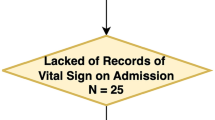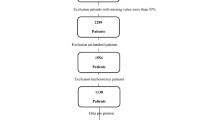Abstract
The use of invasive mechanical ventilation (IMV) is crucial in rescuing patients with respiratory dysfunction. Accurately predicting the demand for IMV is vital for clinical decision-making. However, current techniques are invasive and challenging to implement in pre-hospital and emergency rescue settings. To address this issue, a real-time prediction method utilizing only non-invasive parameters was developed to forecast IMV demand in this study. The model introduced the concept of real-time warning and leveraged the advantages of machine learning and integrated methods, achieving an AUC value of 0.935 (95% CI 0.933–0.937). The AUC value for the multi-center validation using the AmsterdamUMCdb database was 0.727, surpassing the performance of traditional risk adjustment algorithms (OSI(oxygenation saturation index): 0.608, P/F(oxygenation index): 0.558). Feature weight analysis demonstrated that BMI, Gcsverbal, and age significantly contributed to the model’s decision-making. These findings highlight the substantial potential of a machine learning real-time dynamic warning model that solely relies on non-invasive parameters to predict IMV demand. Such a model can provide technical support for predicting the need for IMV in pre-hospital and disaster scenarios.
Graphical Abstract










Similar content being viewed by others
References
Patnaik R, Misra R, Azim A et al (2021) Evaluation of ventilator associated events in critically ill patients with invasive mechanical ventilation: a prospective cohort study at a resource limited setting in Northern India. J Crit Care 64:29–35. https://doi.org/10.1016/j.jcrc.2021.03.001
Evans AM, Mahmoud AD, Moral-Sanz J, Hartmann S (2016) The emerging role of AMPK in the regulation of breathing and oxygen supply. Biochem J 473:2561–2572. https://doi.org/10.1042/BCJ20160002
Linsuwanon P, Payungporn S, Samransamruajkit R et al (2009) High prevalence of human rhinovirus C infection in Thai children with acute lower respiratory tract disease. J Infect 59:115–121. https://doi.org/10.1016/j.jinf.2009.05.009
Huaringa AJ, Francis WH (2019) Outcome of invasive mechanical ventilation in cancer patients: Intubate or not to intubate a patient with cancer. J Crit Care 50:87–91. https://doi.org/10.1016/j.jcrc.2018.11.014
Zanini M, Nery RM, Buhler RP et al (2016) Preoperative maximal expiratory pressure is associated with duration of invasive mechanical ventilation after cardiac surgery: an observational study. Heart Lung 45:244–248. https://doi.org/10.1016/j.hrtlng.2016.01.003
Vallabhajosyula S, Dunlay SM, Kashani K et al (2019) Temporal trends and outcomes of prolonged invasive mechanical ventilation and tracheostomy use in acute myocardial infarction with cardiogenic shock in the United States. Int J Cardiol 285:6–10. https://doi.org/10.1016/j.ijcard.2019.03.008
Cheung JC-H, Ho LT, Cheng JV et al (2020) Staff safety during emergency airway management for COVID-19 in Hong Kong. Lancet Respir Med 8:e19. https://doi.org/10.1016/S2213-2600(20)30084-9
Miraflor E, Chuang K, Miranda MA et al (2011) Timing is everything: delayed intubation is associated with increased mortality in initially stable trauma patients. J Surg Res 170:286–290. https://doi.org/10.1016/j.jss.2011.03.044
Hyland SL, Faltys M, Hüser M et al (2020) Early prediction of circulatory failure in the intensive care unit using machine learning. Nat Med 26:364–373. https://doi.org/10.1038/s41591-020-0789-4
Shehab M, Abualigah L, Shambour Q et al (2022) Machine learning in medical applications: a review of state-of-the-art methods. Comput Biol Med 145:105458. https://doi.org/10.1016/j.compbiomed.2022.105458
Parreco J, Hidalgo A, Parks JJ et al (2018) Using artificial intelligence to predict prolonged mechanical ventilation and tracheostomy placement. J Surg Res 228:179–187. https://doi.org/10.1016/j.jss.2018.03.028
Siu BMK, Kwak GH, Ling L, Hui P (2020) Predicting the need for intubation in the first 24 h after critical care admission using machine learning approaches. Sci Rep 10:20931. https://doi.org/10.1038/s41598-020-77893-3
Bendavid I, Statlender L, Shvartser L et al (2022) A novel machine learning model to predict respiratory failure and invasive mechanical ventilation in critically ill patients suffering from COVID-19. Sci Rep 12:10573. https://doi.org/10.1038/s41598-022-14758-x
Osawa EA, Maciel AT (2022) An algorithm to predict the need for invasive mechanical ventilation in hospitalized COVID-19 patients: the experience in Sao Paulo. Acute Crit Care 37:580–591. https://doi.org/10.4266/acc.2022.00283
Nemati S, Holder A, Razmi F et al (2018) An interpretable machine learning model for accurate prediction of sepsis in the ICU. Crit Care Med 46:547–553. https://doi.org/10.1097/CCM.0000000000002936
Kuzniewicz MW, Vasilevskis EE, Lane R et al (2008) Variation in ICU risk-adjusted mortality: impact of methods of assessment and potential confounders. Chest 133:1319–1327. https://doi.org/10.1378/chest.07-3061
Johnson AEW, Pollard TJ, Shen L et al (2016) MIMIC-III, a freely accessible critical care database. Sci Data 3:160035. https://doi.org/10.1038/sdata.2016.35
Thoral PJ, Peppink JM, Driessen RH et al (2021) Sharing ICU patient data responsibly under the Society of Critical Care Medicine/European Society of Intensive Care Medicine Joint Data Science Collaboration: the Amsterdam University Medical Centers Database (AmsterdamUMCdb) example. Crit Care Med 49:e563–e577. https://doi.org/10.1097/CCM.0000000000004916
(2022) Deep learning and data augmentation based data imputation for structural health monitoring system in multi-sensor damaged state. Measurement 196:111206. https://doi.org/10.1016/j.measurement.2022.111206
Ke G, Meng Q, Finley T et al (2017) LightGBM: a highly efficient gradient boosting decision tree. Proceedings of the 31st International Conference on Neural Information Processing Systems. Curran Associates Inc, Red Hook, NY, USA, pp 3149–3157
Subha Ramakrishnan M, Ganapathy N (2022) Extreme gradient boosting based improved classification of blood-brain-barrier drugs. Stud Health Technol Inform 294:872–873. https://doi.org/10.3233/SHTI220612
Zhang P-B, Yang Z-X (2018) A novel AdaBoost framework with robust threshold and structural optimization. IEEE Trans Cybern 48:64–76. https://doi.org/10.1109/TCYB.2016.2623900
Svetnik V, Liaw A, Tong C et al (2003) Random forest: a classification and regression tool for compound classification and QSAR modeling. J Chem Inf Comput Sci 43:1947–1958. https://doi.org/10.1021/ci034160g
Nouraei Sa. S, Huys QJM, Chatrath P et al (2007) Screening patients with sensorineural hearing loss for vestibular schwannoma using a Bayesian classifier. Clin Otolaryngol 32:248–254. https://doi.org/10.1111/j.1365-2273.2007.01460.x
Lippmann R (1987) An introduction to computing with neural nets. IEEE ASSP Mag 4:4–22. https://doi.org/10.1109/MASSP.1987.1165576
Dreiseitl S, Ohno-Machado L (2002) Logistic regression and artificial neural network classification models: a methodology review. J Biomed Inform 35:352–359. https://doi.org/10.1016/s1532-0464(03)00034-0
Ferguson ND, Fan E, Camporota L et al (2012) The Berlin definition of ARDS: an expanded rationale, justification, and supplementary material. Intensive Care Med 38:1573–1582. https://doi.org/10.1007/s00134-012-2682-1
Thomas NJ, Shaffer ML, Willson DF et al (2010) Defining acute lung disease in children with the oxygenation saturation index. Pediatr Crit Care Med 11:12–17. https://doi.org/10.1097/PCC.0b013e3181b0653d
Zhang G, Xu J, Wang H et al (2022) An interpretable deep learning algorithm for dynamic early warning of posttraumatic hemorrhagic shock based on noninvasive parameter. Biomed Signal Process Control 77:103779. https://doi.org/10.1016/j.bspc.2022.103779
Gepperth A, Hammer B (2016) Incremental learning algorithms and applications. In: European symposium on artificial neural networks (ESANN). Bruges, Belgium. https://pub.uni-bielefeld.de/record/2909368
Jiao Y, Du P (2016) Performance measures in evaluating machine learning based bioinformatics predictors for classifications. Quant Biol 4:320–330. https://doi.org/10.1007/s40484-016-0081-2
Gupta V, Mittal M (2019) QRS complex detection using STFT, chaos analysis, and PCA in standard and real-time ECG databases. J Inst Eng India Ser B 100:489–497. https://doi.org/10.1007/s40031-019-00398-9
Gupta V, Mittal M (2020) Arrhythmia detection in ECG signal using fractional wavelet transform with principal component analysis. J Inst Eng India Ser B 101:451–461. https://doi.org/10.1007/s40031-020-00488-z
Gupta V, Mittal M (2020) Efficient R-peak detection in electrocardiogram signal based on features extracted using Hilbert transform and Burg method. J Inst Eng India Ser B 101:23–34. https://doi.org/10.1007/s40031-020-00423-2
Sánchez-Cifo MÁ, Montero F, Lopez MT (2023) A methodology for emotional intelligence testing in elderly people with low-cost EEG and PPG devices. J Ambient Intell Human Comput 14:2351–2367. https://doi.org/10.1007/s12652-022-04490-9
Chen M, Hernández A (2022) Towards an explainable model for sepsis detection based on sensitivity analysis. IRBM 43:75–86. https://doi.org/10.1016/j.irbm.2021.05.006
Gupta V, He B, Sethi SP A Simplistic and novel technique for ECG signal pre-processing. IETE J Res. https://doi.org/10.1080/03772063.2022.2135622
Gupta V, Kanungo A, Kumar P et al (2023) A design of bat-based optimized deep learning model for EEG signal analysis. Multimed Tools Appl 82:45367–45387. https://doi.org/10.1007/s11042-023-15462-2
Breslow MDMJ, PharmD OB (2012) Severity scoring in the critically ill: part 2: maximizing value from outcome prediction scoring systems. Chest 141:518–527. https://doi.org/10.1378/chest.11-0331
Schwager E, Nabian M, Liu X, et al Machine learning modelling for predicting the utilization of invasive and non-invasive ventilation throughout the ICU duration. Healthcare Technology Letters n/a: https://doi.org/10.1049/htl2.12081
Caleb W. PhD H, Gari D. PhD C, Andrew T. MD R Clinician blood pressure documentation of stable intensive care patients: an intelligent archiving agent has a higher association with future hypotension. https://yc.mlpla.mil.cn/s/com/ovid/oce/G.https/journals/aaprac/201105000/00003246-201105000-00012. Accessed 20 Mar 2024
Smith J a.L, Jennings KP, Anderson EA et al (2004) Reducing call-to-needle times: the critical role of pre-hospital thrombolysis. QJM 97:655–661. https://doi.org/10.1093/qjmed/hch111
GhoshRoy D, Alvi PA, Santosh KC (2023) Unboxing industry-standard AI models for male fertility prediction with SHAP. Healthcare 11:929. https://doi.org/10.3390/healthcare11070929
GhoshRoy D, Alvi PA, Santosh KC (2023) AI tools for assessing human fertility using risk factors: a state-of-the-art review. J Med Syst 47:91. https://doi.org/10.1007/s10916-023-01983-8
Author information
Authors and Affiliations
Corresponding author
Additional information
Publisher's Note
Springer Nature remains neutral with regard to jurisdictional claims in published maps and institutional affiliations.
Rights and permissions
Springer Nature or its licensor (e.g. a society or other partner) holds exclusive rights to this article under a publishing agreement with the author(s) or other rightsholder(s); author self-archiving of the accepted manuscript version of this article is solely governed by the terms of such publishing agreement and applicable law.
About this article
Cite this article
Zhang, G., Xie, Q., Wang, C. et al. Intelligent alert system for predicting invasive mechanical ventilation needs via noninvasive parameters: employing an integrated machine learning method with integration of multicenter databases. Med Biol Eng Comput 62, 3445–3458 (2024). https://doi.org/10.1007/s11517-024-03143-7
Received:
Accepted:
Published:
Issue Date:
DOI: https://doi.org/10.1007/s11517-024-03143-7




